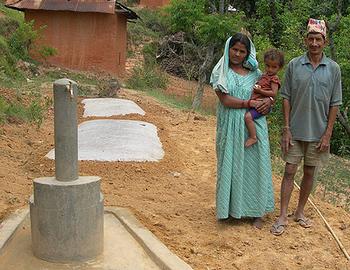Difference between revisions of "Water Portal / Rainwater Harvesting / Multiple Use Services (MUS)"
(→Manuals, videos and links) |
(→Manuals, videos and links) |
||
| Line 17: | Line 17: | ||
==Manuals, videos and links== | ==Manuals, videos and links== | ||
| − | * [http://www.rockefellerfoundation.org/uploads/files/6017a66b-db64-46ca-97ff-2db8e873cc04.pdf A Guide to Multiple-Use Water Services]. Winrock International. | + | * PDF: [http://www.rockefellerfoundation.org/uploads/files/6017a66b-db64-46ca-97ff-2db8e873cc04.pdf A Guide to Multiple-Use Water Services]. Winrock International. |
<br> | <br> | ||
Revision as of 06:41, 3 September 2013

Multiple-use water services (MUS) is an innovative approach to water services. It unlocks new investment opportunities for poverty reduction and gender equity in peri-urban and rural areas. MUS takes people’s multiple water needs as the starting point of planning and design of new systems and upgrades. Universally, water users already use ‘domestic’ systems or ‘irrigation’ systems for multiple purposes, whether legal or not. By planning for these multiple uses, many more benefits from investments in infrastructure can be realized: health, freedom from domestic chores, food and income and gender equity.
Multiple-use water services is a holistic approach to
sustainable water services that improves health and livelihoods.

Homestead-scale MUS: 50 – 200 litres per capita per day
Whenever water is available near homes and on adjoining lands, or ‘homesteads’, people use such water for domestic and many productive uses. This empirical relationship between water uses and availability is depicted in the ‘multiple-use water ladder’. The policy recommendation is to enable poor people ‘to climb the water ladder’ and to provide 50-200 liters per capita per day. Out of this, 3-5 liters per capita per day should be safe for drinking. Income generated enable repayment of most multiple-use systems investments within three years. Homestead-scale MUS is especially beneficial for women, who are disproportionately responsible for domestic water supplies and tend to have a stronger say over homestead production. The land-poor, who only have access to homestead land, also benefit.
Community-scale MUS: local-level integrated water resource management
Here MUS takes communities as entry point of water services. It holistically considers their multiple water uses (domestic, irrigation, animal watering, tree-growing, fisheries, enterprises, ceremonies, environment) from multiple water sources (rain, surface water, groundwater, wetlands) at multiple sites (homesteads, fields, open access). This integrated water resource management at the local level is (potentially) considerably more cost-effective and sustainable than single-use water services.
Manuals, videos and links
- PDF: A Guide to Multiple-Use Water Services. Winrock International.
Water System (MUS) Program
Acknowledgements
- Models For Implementing Multiple-Use Water Supply Systems For Enhanced Land And Water Productivity, Rural Livelihoods And Gender Equity – Multiple Use Systems (MUS). Ongoing research - CIGAR.
